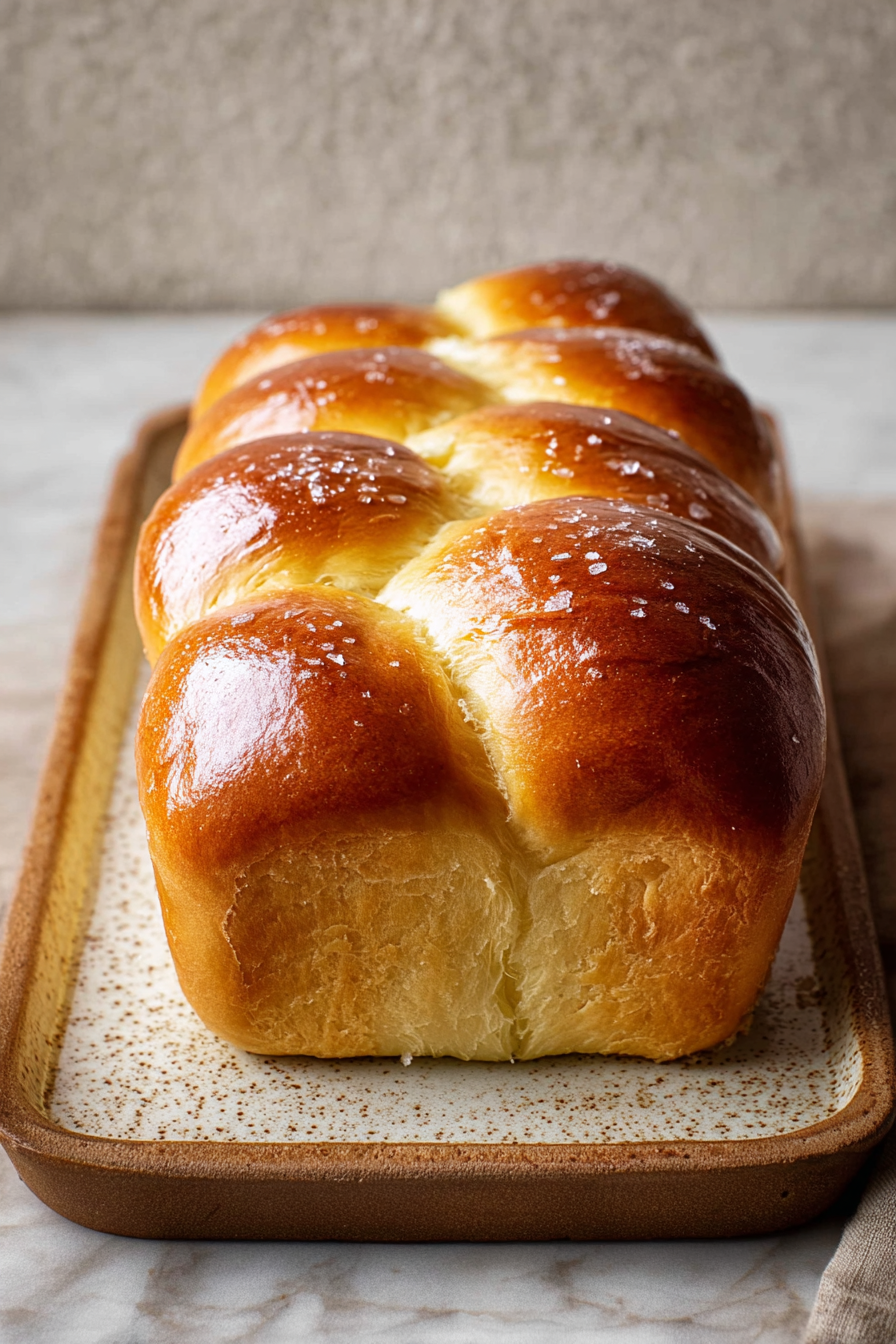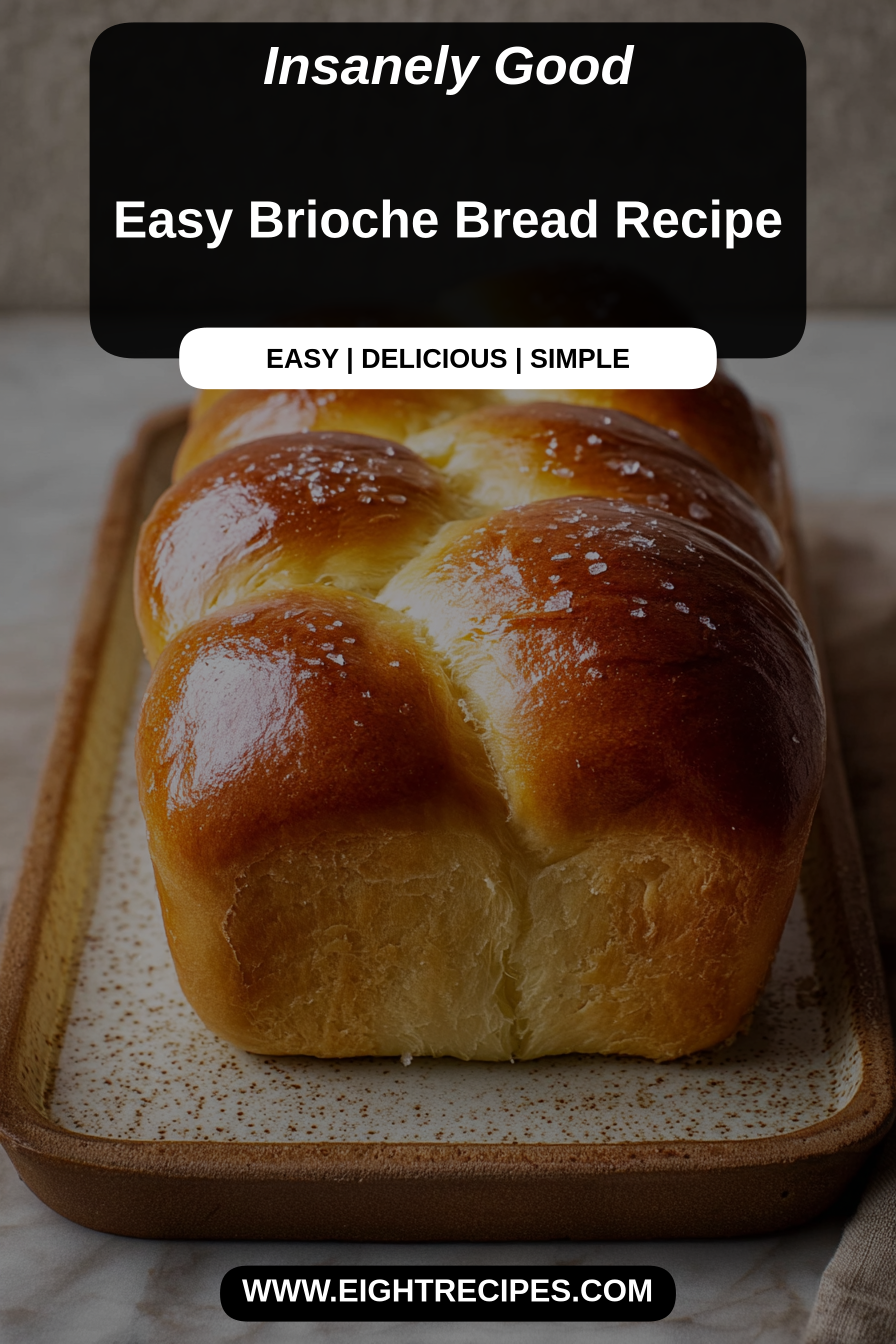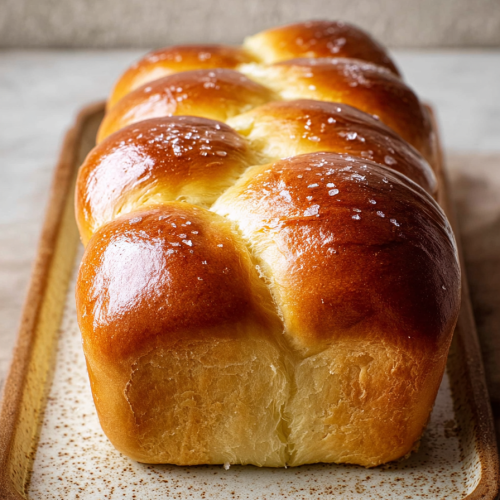Easy Brioche Bread Recipe

There’s something a little celebratory about brioche: the glossy crust, the pillowy, buttery crumb, and that aroma that makes the whole house feel like a French bakery for an afternoon.
My husband is convinced I have a secret pastry chef tucked away somewhere because whenever I pull a loaf of this brioche from the oven he declares it “officially dinner.” Our toddler loves tearing off the edges and eating them like warm rolls, and weekend mornings often turn into improvised French toast feasts. It became a staple not because it’s difficult, but because the rhythm of making it—measuring, kneading, watching the dough bloom—gave our family a little ritual. Once we started freezing sliced loaves, it went from a weekend treat to a weekday hero: toast one slice, spread a smear of jam, and suddenly mornings feel slow and luxurious.
Why You’ll Love This Easy Brioche Bread Recipe
– Enriched, tender crumb that stays soft for days — perfect for toast, sandwiches, and indulgent breakfasts.
– A forgiving dough: with a little patience and the right chill times, it rewards you even if you don’t knead for ages.
– Makes excellent make-ahead bread; freeze slices for quick breakfasts or pull a whole loaf for a cozy dessert.
– Versatile — shape it as a classic loaf, buns, or a pull-apart braid to match the mood.
Behind the Recipe
This brioche is all about balance: enough butter and eggs to be luxuriously tender, but not so much that the dough can’t hold structure. I’ve learned to respect temperature — cold butter doesn’t incorporate, and butter that’s too soft makes the dough greasy. The biggest trap for home bakers is impatience: the dough benefits from gentle kneading and a couple of proofing steps; rushing it usually yields a tighter crumb. I like to work a little extra time on the final shape, brushing with a glossy egg wash so the loaf bakes up beautifully. When it comes out with that deep golden color and a bouncy interior, it’s impossible not to be smug.
Shopping Tips
– Baking Basics: Choose a strong bread flour or all-purpose with a higher protein content for the best structure; check your yeast’s expiration date.
– Eggs: Use large eggs at room temperature for proper emulsification; cold eggs can slow dough development.
– Dairy: Whole milk and unsalted butter give the richest flavor; if using salted butter, reduce added salt slightly.
– Fats & Oils: Unsalted butter is preferred so you control seasoning—use European-style butter for a deeper buttery note if you want to splurge.
– Flavor Boosts: A vanilla bean or a little zest (orange or lemon) can brighten the loaf; add sparingly so it doesn’t overpower the buttery profile.
Prep Ahead Ideas
– You can mix and knead the dough the night before, cover it tightly, and refrigerate to complete the first rise slowly overnight. This deepens flavor and makes morning baking easy.
– Portion and shape the dough, then freeze unbaked loaves or buns on a tray; once frozen, transfer to a bag and bake from frozen with a slightly longer proof time.
– Measure and sift dry ingredients in advance and keep wet ingredients at room temperature in sealed containers to speed assembly.
– Make the egg wash and zest the citrus ahead of time and store separately in the fridge; combine just before brushing the loaf.
Time-Saving Tricks
– Use a stand mixer with a dough hook to save arm work and get a consistent knead; it’s especially helpful when incorporating large amounts of butter.
– Keep mise en place: have eggs, milk, and butter ready and at the right temperature so the process flows without stops.
– If you’re short on proofing time, let the dough rise in a warm (off) oven with the light on; just watch carefully so it doesn’t overproof.
– Freezing slices means you can still enjoy freshly toasted brioche without starting from scratch—toast straight from frozen.
Common Mistakes
– Under or over-kneading: under-kneaded dough won’t develop structure and will be dense; over-kneaded dough can become sticky and hard to handle. I once kept kneading a batch until it felt supple and then added more flour—result: dry brioche. If the dough seems too loose, chill it briefly to firm up before shaping.
– Butter temperature: if the butter is too cold it won’t incorporate; if it’s too warm it’ll smear and make the dough greasy. Aim for soft but still cool.
– Rushing proofing: if it’s not allowed to proof enough, you’ll get a compact loaf. If it overproofs, it can collapse in the oven; learn to judge by volume and a gentle poke test.
– Fixes: If the crumb is too tight after baking, toast slices to revive them for sandwiches, or repurpose stale or dense brioche for bread pudding or breadcrumbs.
What to Serve It With
This brioche sings with simple, high-quality additions: a smear of salted butter and jam, thick-cut bacon and cheddar for hearty sandwiches, soft scrambled eggs for brunch, or soak it for a decadently custardy bread pudding. It also makes outstanding French toast—crispy edges, custardy middle.
Tips & Mistakes
A thin, even egg wash gives the glossy, deep-brown finish everyone loves—don’t overdo it or the crust will be too shiny and mask the crumb inside. When slicing, use a serrated knife and let the loaf cool at least 20–30 minutes to avoid crushing the soft interior. If a loaf collapses slightly after baking, it’s often just a proofing timing issue; slice and use for sandwiches or toast rather than starting over.
Storage Tips
Store in airtight containers in the fridge. It reheats beautifully, but if you sneak a bite cold straight from the container, it still works. For longer storage, slice and freeze in single portions; toast or warm gently from frozen.
Variations and Substitutions
A touch of sugar or honey will deepen the flavor; swap in a darker sugar for richer caramel notes. For a lighter loaf, reduce the butter slightly, but know the texture will be less tender. Non-dairy substitutions change the character—use a high-quality vegan butter and a milk alternative, but expect a different crumb. Instant yeast works fine in place of active dry; just adjust the proofing times. When in doubt, keep the classic ratio of eggs and butter—the traditional brioche richness is worth preserving.

Write me the frequently asked questions and answers Easy Brioche Bread Recipe in the same way as the example below.
Frequently Asked Questions

Easy Brioche Bread Recipe
Ingredients
Main Ingredients
- 0.5 cup granulated sugar helps in sweetening the dough
- 0.25 cup whole milk for the dough texture
- 0.5 cup unsalted butter melted for richness
- 0.5 cup active dry yeast for leavening
- 4 cups all-purpose flour base of the bread
- 4 large eggs adds flavor and moisture
- 1 tsp salt balances sweetness
Instructions
Preparation Steps
- Start by warming the milk until it's just a bit warm to the touch. Mix in the yeast and a pinch of sugar, then let it sit for about 5-10 minutes until it becomes frothy. This means the yeast is active.
- In a large bowl, combine the flour, sugar, and salt. In a separate bowl, whisk together the eggs and melted butter, then add them to the dry ingredients along with the frothy yeast mixture. Stir until the dough just comes together.
- Knead the dough on a floured surface for about 8-10 minutes until it's smooth and elastic. Form it into a ball and place it in a greased bowl, covering it with a clean cloth. Let it rise in a warm place for about 1 hour or until it has doubled in size.
- Once risen, punch down the dough and turn it out onto a floured surface. Shape it into a loaf and place it in a greased loaf pan. Cover it again and let it rise for another 30 minutes.
- Preheat your oven to 375°F (190°C). When the dough is ready, bake it for about 25-30 minutes or until it turns golden brown. A nice hollow sound when tapped on the bottom means it's done!
- Allow the bread to cool in the pan for a few minutes before transferring it to a wire rack. Enjoy this soft brioche warm or toasted with your favorite toppings!
